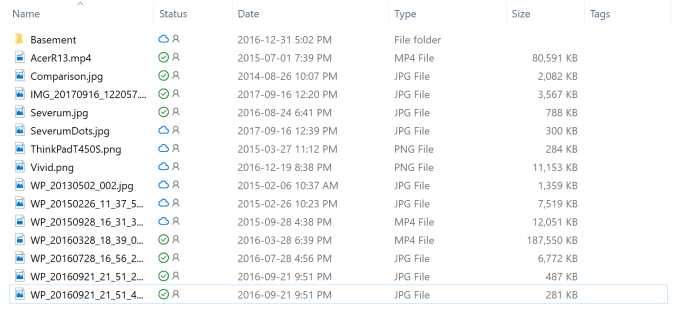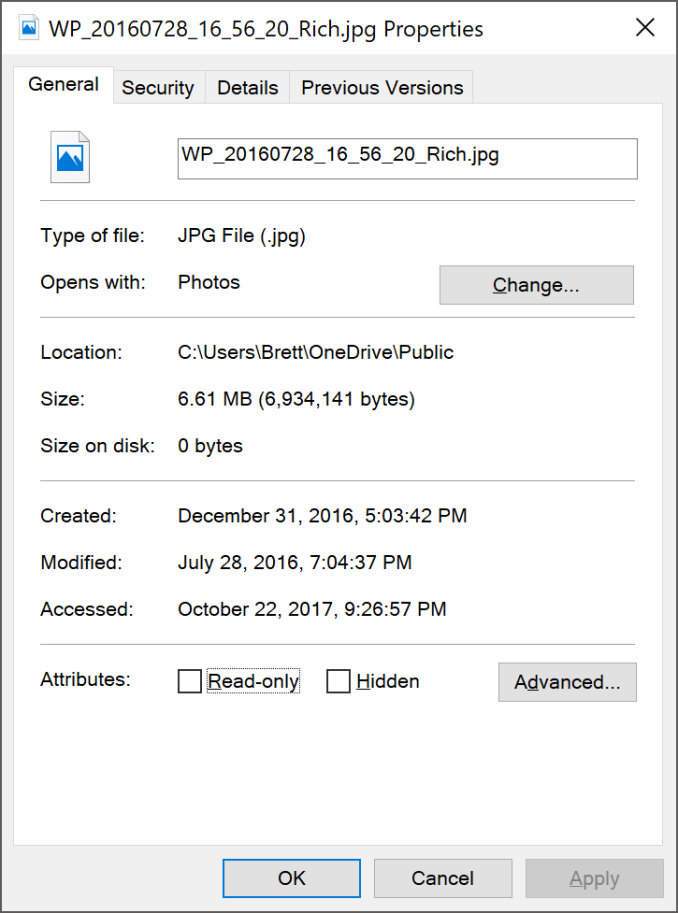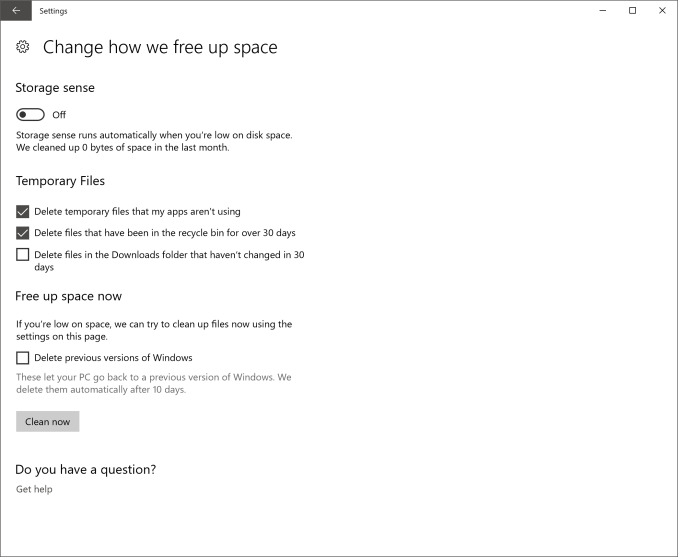The Windows 10 Fall Creators Update Feature Focus
by Brett Howse on November 10, 2017 8:00 AM ESTOneDrive Files on Demand
I’ll admit, I’m a heavy user of OneDrive. It was a tough pill to swallow when Windows 10 launched and removed the support for OneDrive placeholders that arrived with Windows 8.1. Placeholders allowed you to see your entire OneDrive collection, even if it wasn’t downloaded to your PC, and then if you needed a file, you could double click it to download and open. It’s a simple concept, but the original implementation had some issues. Some of the issues were end-user related, such as people not understanding a file they had access to at home might not be available to them on an airplane, and some of them were app issues with the extended delays that might occur when waiting to download a file.
With the new Files on Demand, hopefully that is all fixed. First off, there’s a new setting in the OneDrive app in the system tray that enables and disables this functionality.
If you really prefer to just have everything downloaded, you can keep the original Windows 10 method where only folders you explicitly say to sync are downloaded. If you want Files on Demand, you have to check the box.
Once checked, files in OneDrive will gain a new status icon to display if they are online or downloaded. As I quickly found out though, it’s a bit confusing, in that OneDrive will still only display folders that you have told it to display in the Select Folders settings. So even if you have 10,000 files in your music folder, you won’t see them unless you first ensure that folder is synced. The difference is now it won’t download the file until you access it.
If you open a file, Windows 10 will automatically download it for you, and then open it. Depending on the size of the file, and your network speed, this could cause some delay, but the space savings will be significant, especially if you have a smaller SSD.
Microsoft has created a settings page for Automatic File Downloads, where you can unblock apps from automatically downloading files. For reasons that don’t seem to make any sense, this setting is under the Privacy section of Settings, and it doesn’t appear to be fleshed out yet, since you can’t block apps here, only unblock them. The wording does make it seem like Microsoft is going to open this up to other online file providers as well, which should be good news for many.
Also, in what is almost certainly a bid to improve performance, if you open a photo, for instance, and it has to be downloaded first, Windows 10 will also automatically download the photo before and after, so that if you move to the next file, it’s already available. This is a good idea for performance, but you may end up downloading lots of files you didn’t need.
Overall, first impressions of Files on Demand is positive. It can be a bit confusing to set up, since unlike Windows 8.1, you have to still tell it which folders you want to see, but the performance is solid, and it is very easy to distinguish between files that are already downloaded and those that are not. You still get a thumbnail for images that aren’t downloaded as well.
Storage Sense
In addition to freeing up space by being able to access your OneDrive files only when you need them, Microsoft has improved Storage Sense in an effort to automatically help clean up files you likely no longer require.
One of the most useful ones, at least for me, will be to delete files in Downloads that haven’t changed in 30 days. That folder tends to accumulate a lot of cruft that doesn’t need to be kept.
In addition, it can automatically empty your recycle bin, temp files, and previous versions of Windows, which are kept for a period of time in case you need to or want to roll back to the last version.
Storage Sense is a small idea, but should be very helpful. It even keeps track of how much space it’s cleaned up for you.
One obvious improvement here would be to integrate this with OneDrive as well, to give the option to clean up space from OneDrive files you haven’t accessed in a while now that Files on Demand can fetch them back quickly. Hopefully this comes in a future update.














95 Comments
View All Comments
prophet001 - Monday, November 13, 2017 - link
Oh that's rich. Google trying to shut off another manufacturer's spyware.rofl
pjcamp - Monday, November 13, 2017 - link
How the hell do you spy on a machine with the power off?BurntMyBacon - Wednesday, November 15, 2017 - link
I think that was referring to a system with power connected, but in the "power off" state. The Intel Management Engine would still draw some power, so it wouldn't really be considered fully powered off. It just hasn't initialized the boot code from UEFI / BIOS / Etc. If I recall correctly, the Intel Management Engine doesn't require boot code to bring it up, but it can be reconfigured by the boot code. This is where coreboot could become useful if you want to disable the engine.Shiitaki - Tuesday, December 5, 2017 - link
It's not that hard to bypass the ME engine, just add an external network card.Ratman6161 - Friday, November 10, 2017 - link
"Microsoft should block ALL applications by default "People love to make sweeping comments like that without thinking through the consequences. Block ALL? Sure. So what does your average home user do then? With everything blocked you have to give them some mechanism to unblock the things they need or want. Unfortunately 99.99% will have no idea....and will click "yes" or "OK" or whatever. OR they won't have any clue what to do and will only know they wanted something and it doesn't work. Then the people who can't figure out how to get to their google docs etc will be on here flaming about the Microsoft Conspiracy to prevent them from using third party products.
Hurr Durr - Saturday, November 11, 2017 - link
This psycho was running around comments not long ago screaming how he "hack-proofed" WinXP and "challenged hackers and various intelligence services around the world" to crack it. Make your conclusions.Bullwinkle-J-Moose - Saturday, December 23, 2017 - link
Which Psycho is that Hurr Durr?I recall running around claiming that they couldn't "wreck" my box but I never said they couldn't "hack" my box
I would NEVER use XP for banking or passwords because even a read only system can be "hacked" but not permanently wrecked
This box is for testing the best of the best malware on the planet and it has often been "hacked"
However, a simple reboot restores it to pristine and fully functional condition by wiping away any malware, so stop trolling with your fake news
Samus - Sunday, November 12, 2017 - link
I trust Microsoft diagnostic submissions a hell of a lot more than amazon, Facebook, or google. As a whole I trust Microsoft and Apple over just about any other tech company because they are the only two that have business models not revolving around ad revenue. That’s partially why Bing failed...it didn’t invade your privacy enough.ddriver - Monday, November 13, 2017 - link
LOL and WOW, how dumb are you. Their business model revolves around milking people in every possible way they can as hard as they can. What an idiocy it is to assume they go though the effort to create an OS that is spyware at its core and they will not monetize on the acquired information just because they have other sources of revenue.prophet001 - Monday, November 13, 2017 - link
They did this in the wake of the sheeple devouring Google's and Apple's creations and paradigms.If you can't beat em, join me.
Microsoft was one of the last bastions of personal privacy in an OS but ya'll told them, through your adoption practices, "hey it's cool. take my stuff" and so they did.